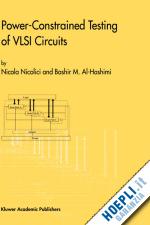
Questo prodotto usufruisce delle SPEDIZIONI GRATIS
selezionando l'opzione Corriere Veloce in fase di ordine.
Pagabile anche con Carta della cultura giovani e del merito, 18App Bonus Cultura e Carta del Docente
Minimization of power dissipation in very large scale integrated (VLSI) circuits is important to improve reliability and reduce packaging costs. While many techniques have investigated power minimization during the functional (normal) mode of operation, it is important to examine the power dissipation during the test circuit activity is substantially higher during test than during functional operation. For example, during the execution of built-in self-test (BIST) in-field sessions, excessive power dissipation can decrease the reliability of the circuit under test due to higher temperature and current density.
Power-Constrained Testing of VLSI Circuits focuses on techniques for minimizing power dissipation during test application at logic and register-transfer levels of abstraction of the VLSI design flow. The first part of this book surveys the existing techniques for power constrained testing of VLSI circuits. In the second part, several test automation techniques for reducing power in scan-based sequential circuits and BIST data paths are presented.











Il sito utilizza cookie ed altri strumenti di tracciamento che raccolgono informazioni dal dispositivo dell’utente. Oltre ai cookie tecnici ed analitici aggregati, strettamente necessari per il funzionamento di questo sito web, previo consenso dell’utente possono essere installati cookie di profilazione e marketing e cookie dei social media. Cliccando su “Accetto tutti i cookie” saranno attivate tutte le categorie di cookie. Per accettare solo deterninate categorie di cookie, cliccare invece su “Impostazioni cookie”. Chiudendo il banner o continuando a navigare saranno installati solo cookie tecnici. Per maggiori dettagli, consultare la Cookie Policy.